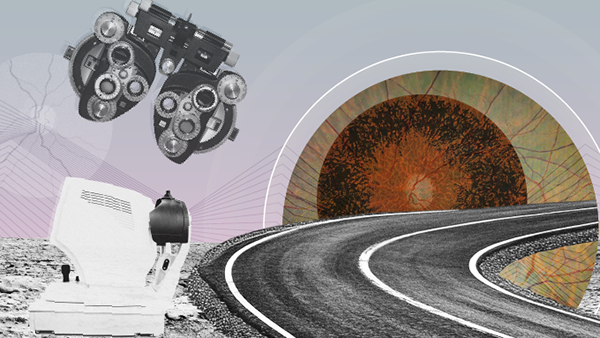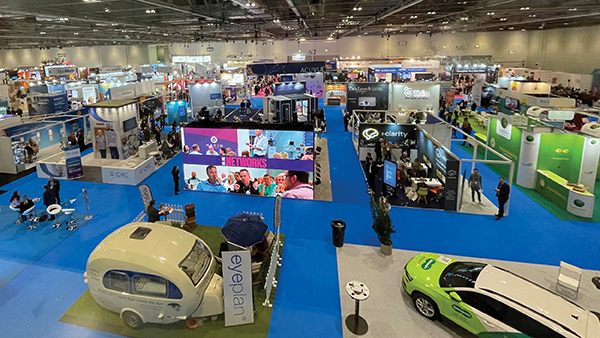Advancing Vision with Technologies for Spaceflight
How head-mounted technologies built for astronauts can be leveraged for human health on Earth
The field of spaceflight embodies humanity’s coordinated efforts to explore the unknown – from rockets to spacewalks, and every small step that helped get us there in the first place. There are, however, a number of deleterious effects that the close-quarters environment can have on the human body, including bone density loss, increased radiation exposure, muscle atrophy, sleep deprivation, and changes to the ophthalmic system.
The most prevalent eye-centric issue astronauts experience during long-duration spaceflight is known as SANS (short for Spaceflight Associated Neuro-ocular Syndrome), which can cause choroidal folds, optic disc edema, posterior globe flattening, and hyperopic refractive shifts. Despite increasing acknowledgment of SANS, its underlying pathophysiology is not well understood, so it is important that we configure possible counteractive measures that support the visual performance of astronauts. In addition, the effects of natural aging and extended exposure to space radiation must also be considered.
Various countermeasures for SANS and space radiation – many of which focus on prevention – have been explored. Another approach I am particularly interested in is a digital solution for cases where natural aging, SANS, or space radiation affect central vision. Extended exploration missions are synonymous with limitations in terrestrial surgical and medical interventions; thus, certain low-mass methods may be the only viable way to uphold vision and mission safety/performance.
Digital metamorphopsia suppression, with augmented reality (AR), is a system that could be of notable use in this regard. The digital technique was developed for monocular central visual deficits, and employs head-mounted technology where the individuals have an AR dark spot suppression over their central vision, which allows their contralateral, non-affected eye to perceive a task without distortion. In fact, our study found that different monocular suppression sizes had varying levels of effects – it was critical that the size of dark spot suppression was large enough to suppress the visual distortion, but not too large as the dark spot may be too noticeable (3).
We also found that this technology could be useful for individuals on Earth with central visual distortions. There exist a number of retinal diseases that instigate such issues – including age-related macular degeneration (AMD), central serous chorioretinopathy, and macular holes. From a quality-of-life standpoint, we know that people affected by these afflictions often experience a notable decrease in independence, which impacts various aspects of their lives (4). As such, those with monocular central distortions may benefit from the mobility and support offered by the system.
If anything, our work has proven that ophthalmic technologies developed for astronauts have powerful use cases for vision on Earth (5). Take the barriers observed in underserved areas for vision care, for example. These places suffer from limited access to ophthalmic providers, imaging modalities, and procedures, which, in turn, has overlapping similarities to the compact spaceflight environment. Aspects of our artificial intelligence frameworks, like generative adversarial networks to synthesize angiograms from non-invasive fundus images, are a direct way in which we can support communities where fluorescein angiography is largely unavailable but where access to fundus photography is typically more common.
As we continue to work towards a safer journey at the final frontier, we look forward to seeing how these technologies can also uphold vision for our communities on Earth.
References
- ZS Patel et al., “Red risks for a journey to the red planet: The highest priority human health risks for a mission to Mars,” NPJ Microgravity, 6, 1 (2020). PMID: 33298950
- TW Olsen et al., “Chorioretinal folds: associated disorders and a related maculopathy,” Am J Ophthalmol, 157, 5 (2014). PMID: 24531022
- J Ong et al., “Head-mounted digital metamorphopsia suppression as a countermeasure for macular-related visual distortions for prolonged spaceflight missions and terrestrial health,” Wearable Technol, 3, e26 (2022). doi:10.1017/wtc.2022.21
- JS Slakter, M Stur, “Quality of life in patients with age-related macular degeneration: impact of the condition and benefits of treatment,” Surv Ophthalmol, 50, 3 (2005). PMID: 15850815
- J Ong et al.,”Terrestrial health applications of visual assessment technology and machine learning in spaceflight associated neuro-ocular syndrome,” NPJ Microgravity, 8, 1, (2022). PMID: 36008494
The New Optometrist Newsletter
Permission Statement
By opting-in, you agree to receive email communications from The New Optometrist. You will stay up-to-date with optometry content, news, events and sponsors information.
You can view our privacy policy here
Most Popular
Sign up to The New Optometrist Updates
Permission Statement
By opting-in, you agree to receive email communications from The New Optometrist. You will stay up-to-date with optometry content, news, events and sponsors information.
You can view our privacy policy here
Sign up to The New Optometrist Updates
Permission Statement
By opting-in, you agree to receive email communications from The New Optometrist. You will stay up-to-date with optometry content, news, events and sponsors information.
You can view our privacy policy here







